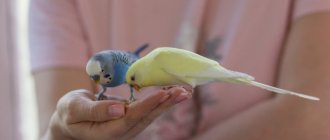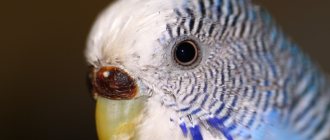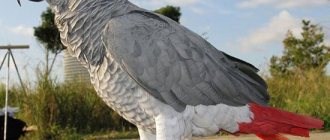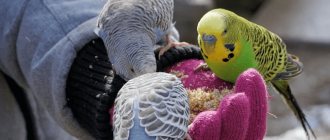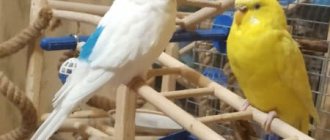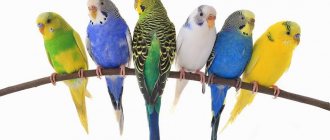It is a miracle to watch how parrots sleep, budgies in particular. After all, these birds are so fragile and delicate. Let's talk about the nuances associated with the duration of daytime and night sleep. Let's find out in what positions parrots prefer to sleep. Let's look at the benefits of rest and what the consequences are if the regime is violated. In conclusion, here are recommendations for creating comfortable sleeping conditions.
How long do parrots sleep in the wild and in captivity?
The owner is always worried at first when he sees that the bird sleeps up to ten hours a day. Then he reads special articles in the encyclopedia about the groundlessness of all anxiety.
In their historical homeland, birds live according to a special schedule. This is Australia - a very distant continent from our snowy lands. These colorful birds of paradise live in the tropical forests there.
Parrot sleep patterns in nature and at home
This is a hot country, the sun there is evil. It shines for a long time, and therefore the night turns out to be short. Parrots don't have time to sleep. They have a lot to do, they need to gain strength.
Even before the first rays, the birds wake up, put themselves in order, greet the rising star, and then do their main job - looking for food. After breakfast they fly to the water to drink.
And the sun, barely rising above the horizon, begins to become unbearably hot. Everyone is hiding in the dense crowns of tropical trees from the scorching heat. They have no choice but to sleep until the evening.
Having seen off the sun with cheerful chirps, they have dinner, chat and fall asleep again until dawn. So the day has passed! Even though there is no such heat in the northern hemisphere, and the forests around us are not similar to Australian ones, but our pets remember their ancient routine very well. The only difference is that here the parrot is resting in his cage.
Read also
How to treat a budgie for ticks at home
How to care for a parrot
Careful care and attention from the owners will help pet parrots to quietly endure the beginning of molting. Considering that during this delicate period, the immunity of feathered pets is significantly reduced, it is necessary to take a number of measures that will protect them from aggressive environmental influences and disease. Such preventive measures include:
- proper balanced nutrition, which will include a high content of beneficial vitamins and minerals;
- organization of walking - free flight around the apartment;
- water procedures;
- control of temperature and humidity in the room where the poultry is kept.
Nutrition during the molting period
During molting, the parrot needs to be fed better, since colossal reserves are spent on the growth of new plumage, and restoring their balance in the body is vital.
| Foods that must be included in the diet of a budgerigar are mandatory. | |||||
| Cereals; Seeds; Nuts; Sesame; | Fruits and berries, dried fruits from them | Vegetables | Greenery | Fermented milk feed | Animal feed |
| Canary seed; Meadow grass seeds; Bran, Special grain premixes “for shedding”. | Apples; Pears; Peaches; Bananas; Citrus; Melons; Cherries; Cherries; Apricots; Raspberries; Blackberry; Strawberry; Blueberry; Cowberry; Grape; Currant. | Carrot; Pumpkin; Zucchini; Cabbage; Cucumbers; Patissons. | Sprouted wheat and oats; Spinach; Dandelion; Plantain; Nettle; Carrot and beet tops; Celery; Chickweed; woodlouse; Shepherd's Purse; Tree branches. | Skimmed milk; Low-fat cottage cheese. | Mealworms; Bloodworm; Drosophila; Grasshoppers; May beetles; Eggs of chickens and quails. |
Vitamins and minerals
During the period of plumage change, the parrot's diet should contain the following minerals:
- meat and bone meal;
- calcium glycerophosphate;
- chalk;
- sand;
- sepia;
- feed sulfur;
- egg shells;
- crushed shells;
- crushed cuttlefish shell.
Preparations with a complex of vitamins are allowed to be given after the parrot is one year old.
Veterinarians recommend that during molting you pay attention to such vitamin mixtures as VitaCraft, VitaSol 8 in 1 UltraWhite, BifarMauser Trofen, BifarVinka, brewer's yeast with the addition of feed sulfur
Parrot bathing
In addition to the fact that there should always be drinking water in the parrot’s cage, he needs to have “bath” days. Budgerigars love to splash around in the water, and during the molting period such procedures are especially recommended, since bathing helps to quickly get rid of old feathers, relieve itching, and improve their mood. Wild parrots bathe in the rain or look for morning dew on tree leaves to “wash themselves.”
To bathe your pet budgie, you can simply turn on the tap and let your pet out of the cage for a walk under such a “shower”. You can use a small container the size of a soup plate, pour water at room temperature into it, and place the container in the bird’s cage. Sometimes there are individuals with a special disposition who do not really like the prospect of being a little “damaged.” They can simply be sprayed with water from a water gun or spray bottle.
Air humidity
As you know, the birthplace of budgerigars is tropical and equatorial regions with high humidity. Therefore, when breeding these birds at home, they need to recreate conditions as close to natural as possible.
The most favorable temperature range is +20C-+25C.
But the most important thing is to maintain humidity in the apartment - it should be more than 60%. With these parameters, the parrot will feel comfortable, and the molting period will pass quickly and painlessly.
Correct sleeping position
The peculiarity of sleeping while sitting on one leg is unique, except that only other species of birds can be compared with cute talkers. Many of them also settle down to take a nap on branches or on a perch.
Sleeping positions for parrots
Adult wavy cats and representatives of other breeds cling to this twig with only one paw. Even the herons have it easier, although they also press their other leg. They stand on the ground, the surface of which does not shake.
Parrots have amazing coordination! It doesn't appear right away. Young chicks sleep on two legs for a long time until they learn how to do it.
There is a second feature of the pose. Try not only balancing on one leg, but also placing your head on your back! Parrots can do it! This situation does not cause them any anxiety; they feel safe and comfortable. Often lovebirds sleep side by side, huddled closely, and one of them rests his head on the back of the other.
Alone or in pairs - which is better?
The budgerigar is a flocking bird that cannot develop adequately without its relatives nearby.
Of course, the bird will greet its owner more joyfully and learn to speak faster, but this is all the result of sadness and sadness in moments of human absence.
Despite the seemingly external satisfaction from life and a cheerful mood, a lonely parrot will not receive what is inherent in it by nature. Even if you spend 24/7 with your pet, this is not enough, because... Bird communication is not just about actual presence or voice. This is also communication with body language, gestures, plumage, coloring.
In animals of the same species, even if there are only two of them, a certain hierarchical behavior is established: one of the parrots becomes a role model. In addition, in pairs, parrots can engage in procedures laid down by genes. This is something that cannot only be taught, but also unlearned.
As the owners of several birds say, monitoring and caring for a pair is much easier than for a single bird, because... in a group, parrots can occupy themselves and will not constantly call their owner across the entire apartment.
How many parrots do you have?
12
Sleep patterns at home
A good owner always knows whether his pet is getting enough sleep, because the bird’s mood depends on this. If he has had enough sleep, he is cheerful, feels good, willingly communicates with his household, causing them to be touched.
Parrot sleep schedule at home
If the bird has not rested enough, it gets bored - restlessness and even anxiety arises. It is incredibly difficult to control a ward, since the parrot's routine differs significantly from our routine.
But there is a way out! The cage should be covered. Or the owner can completely change his lifestyle, adapting to his pet.
Content Features
A pair of budgies in one cage requires additional attention and care from the owner, so it is important to follow a number of rules in relation to the cage and feeder for keeping two parrots
Cell
Budgerigars are not picky about their habitat, so you should follow only a few simple rules in
The cage must accommodate two birds with their wings fully extended, because they jump from branch to branch with the help of their wings. Otherwise, they may damage their wings on the bars.
The approximate dimensions of the cage should be within 60x30x40 cm, but you need to take into account the individual characteristics of the pet, because a budgerigar can be a large individual and then the indicated dimensions will not be enough. Ideally, measure the length of the bird's wings and the width of the bird's body to get a complete idea of the comfortable size of the cage.
The shape of the cage should be rectangular with a semicircular roof. It is very difficult for a parrot to navigate in cylindrical, cone-shaped, round or shaped cages
Attention should also be paid to the gaps between the rods. They should be without points or protrusions, so as not to damage the birds’ legs.
In addition, horizontal bars allow the parrot to move freely around the cage using not only the floor and branches, but also the walls.
Budgerigars strive to be close to their owner, so you need to be prepared for escape attempts.
To prevent this and avoid injury, the gap between the bars should be at least 1-1.5 cm. In this situation, the budgerigars will physically not be able to insert anything other than their beak into the gap.
If we are talking about the beak, then it is worth talking about the material used to make the cage. Living in pairs, birds like to take turns eating, but in the process they “chew” the twigs.
Ornithologists say that this is one of the ways birds communicate with their owner, because the beak is activated, accompanied by a characteristic sound. It follows from this that grids made of galvanized metals (lead, zinc, copper) are strictly contraindicated.
Feeder
Budgerigars need to be fed from several feeders, which is dictated by their diet. So, you need to stock up on at least two containers: one for grain, the other for mineral delicacies. Birds are very picky creatures, so ornithologists do not recommend mixing different foods in one bowl, so it is ideal to have a third feeder for all other types of food.
Parrots may have conflicts if they eat from the same feeder and drink from the same water bowl. The optimal solution is to purchase a special large bowl for feeding parrots, which can comfortably accommodate both pets
An automatic drinking bowl is used for a pair of parrots. This is due to the fact that, being in the same cage, a couple can play with each other, which often leads to overflowing a regular drinking bowl.
How to create comfortable conditions for a feathered pet to rest?
I have already talked about how the sleep of little parrots is organized. Now let's talk about the big ones. For example, a cockatiel is quite large and strong, how can you please it? There is nothing to be afraid of.
Creating comfortable conditions for the parrot to rest
With proper care and sufficiently large space for living, this pet seems unpretentious. Breeds like this require space and freedom. It is better to give the bird the entire room at its disposal, but first remove dangerous objects from there.
In a cramped cage one cannot avoid depressed mood, apathy, and subsequently even muscle dystrophy. Corella does not want such a fate, and therefore may rebel and show aggression.
You need to be given the opportunity to hide or retreat somewhere, and if there is nowhere to hide from the apparent danger, the strong-billed flyer will certainly attack. This is his only defense in this situation.
Consequences of lack of sleep in parrots
And the more he worries about his safety, the less soundly he sleeps. And chronic lack of sleep threatens many health problems.
For example:
- shedding feathers in incredible quantities;
- furious self-plucking;
- lethargy, drowsiness;
- nervous behavior;
- aggression;
- depression;
- acquiring offspring contrary to the plans of the owner.
Possible complications
Your feathered pet doesn't care about the fact that you have an irregular sleep schedule. You can go to bed at any time you want, but your bird needs to get enough sleep.
Due to the lights not being turned off at night and extraneous noise (TV, music, guests talking), the parrot cannot sleep. For proper bird sleep, the room where the cage hangs should be dark and quiet. If the “wavy” does not get enough sleep at night, he will sleep during the day.
If you do not take care of your pet’s physical and mental condition and ignore its needs, then it is unlikely that it will be healthy, cheerful and active. Due to chronic lack of sleep, a budgerigar may develop the following problems:
- unnatural loss of feathers;
- self-plucking;
- constant drowsiness and lethargy;
- state of apathy;
- nervousness;
- depression;
- aggression;
- lack of appetite;
- unplanned egg laying.
In order for a budgerigar to get enough sleep, the duration of its sleep in the summer should reach ten to twelve hours, and in the winter - twelve to fourteen hours.
In order not to harm the health of your feathered pet, you need to provide him with optimal conditions for rest. The budgie begins to fall asleep when it gets dark. For proper sleep, at the appropriate time it is necessary to cover the bird’s cage with a breathable, dense fabric. Thanks to this, she will decide that it is time to sleep.
In the summer, when it gets dark outside the window, cover the cage around nine o'clock in the evening. Then your pet will sleep for the prescribed ten to twelve hours. In winter, you will have to put the bird to bed earlier - between five and seven hours. And she will be able to sleep for about twelve to fourteen hours.
Should the cage be covered at night?
Why is it necessary to cover a bird’s cage: myths and truth
A person must make a choice: whether it is necessary or not, whether to hide the bird or not. Many consider thick fabric a necessity - to protect the pet from drafts and from lamp light, which someone needs for work.
Should I cover my parrot's cage?
People are also looking for some convenience for themselves in this action: the parrot is aggressive, restless, screams early in the morning if there is no cape. In any case, he will have to be specially accustomed to such a blanket.
Consequences of violating the regime
If a person does not monitor his pet’s diet, this can lead to significant negative consequences.
For example, if you turn on the lights at night or don’t let the bird sleep for the allotted time, the following problems arise:
- feather loss;
- during the day the parrot becomes lethargic and drowsy;
- the bird becomes depressed and does not want to play;
- the wavy dog shows aggression and is nervous in the presence of a person;
- Unplanned egg laying begins in females.
Sometimes the bird plucks its feathers itself, so you need to make timely adjustments by adjusting the wavy mode.
How do supporters of a positive solution explain their position?
- Compliance with daylight rules.
- Preventing unexpected egg laying.
- Normalization of hormonal balance.
Read also
How to determine the age of a budgerigar
There are arguments that the bird’s sleep and wakefulness patterns can be instilled according to one’s own calculations, ignoring their natural predisposition to a much more complex routine. This can also contribute to success in taming the noisy troublemaker and subordinating it to its owner. To put it mildly, it will increase discipline.
What are the benefits of getting a good night's sleep?
If you can't get enough sleep at night, the parrot will make up for the lack of sleep during the day. In addition to the normal duration of at least 10 hours, sleep should be sound and restful. Why is proper rest so important for birds?
- During sleep, expended energy is replenished;
- the body is restored;
- the state of the nervous system is stabilized;
- immunity is strengthened.
Brief breaks during the daytime promote muscle relaxation, a kind of relaxation. Having had a hearty snack, the parrot dozes off, and metabolic processes go on as usual.
What and how is correct?
The fabric chosen is dark, not very dense. In front it should not fall to the base of the cage; on the sides there should be complete darkness. One wall is always open, otherwise the bird will suffocate. The deprivation of light must be gradual.
Choosing the right fabric
First, place the blanket only on top and turn off the large lamps. Leave a table lamp or night light. Let your pet realize that it is twilight for him.
When this happens, he will calm down. At this time, it would be good to have a heart-to-heart talk with him - quietly and affectionately. When he sits on his perch, you can cover the cage as expected.
Creating favorable conditions
A pet sometimes needs a quiet, calm environment. If there are children living in the house, to prepare for bed it is better to place the cage away from the children's screams and enthusiastic emotions. While your pet is sleeping, it is not recommended to slam the door, stomp your feet, make loud noises, turn on music or TV, or talk loudly on the phone. If the bird falls asleep at noon, you need to follow the “library” mode.
When there is a loud noise, pets can muffle the sound on their own by tightly packing their feathers in the area of their ear openings.
Young individuals need special attention, as they are not yet adapted to independent living. Before going to bed, the best option would be to remove the perches to the bottom of the cage, as falls from a height are not uncommon. You can use cardboard to create a low mound on which the bird will sleep soundly and gain strength.
When it gets dark, it is better to cover the cage with a blanket, leaving a few holes for air circulation. If an individual does not get enough sleep at night, it will gain strength during the day. The owners will be required to show compassion and respect for the pet; during sleep, the pet should not be disturbed or woken up.
Should the cage be covered at night?
You can cover the cage with a cape (you can buy it in stores) only at night, as the biorhythmic clock is better activated.
If the room does not require ventilation, then it is better to leave the front part of the cage slightly open to free access to air. The bedspread should be chosen from fine natural fittings, for example, linen, but not wool; do not use a towel, synthetics, wool, or cotton, since the products do not allow oxygen to pass through well.
Possible sleep disorders and how to deal with them
Problems with daytime sleep
During the day, parrots almost always rest, especially after eating, this gives them strength. There is no reason to worry. But if the bird sleeps for a long time at night, and does not have fun during the day, constantly nods, or loses its appetite, observation is required.
Problems with your parrot's naps
This happens during seasonal molting. Its signs are easy to notice - the bottom of the cage is covered with fluff. This will pass. When the underlying cause of daytime sleepiness cannot be determined, you should contact your veterinarian.
Difficulties
It's your own business when you go to bed. You can do this constantly at different times. You can generally stay awake all night. But don't forget that you don't live alone. Your pet needs to get some sleep . Therefore, in the room where the parrot is located, the lights should be turned off . Also, no noise should enter the room and disturb your feathered friend's sleep. At night (in the evening), the budgie must get enough sleep, otherwise it will sleep during the day. As a result, the mental and physical condition of your bird will be impaired. She will become sad, sick, and will not enjoy life.
Night sleep disorders
It's a bad sign if the parrot doesn't sleep after dark. He probably complains, making loud and incomprehensible sounds. He doesn’t sit still, he rushes about. First of all, you need to carefully examine the bird for any injuries.
She could fall from the perch in her sleep, losing her balance, and hurt herself. If a wound is found, it is treated in the same way as a child’s – with hydrogen peroxide, for example. But there may be a turning point. In the morning, it is advisable to show your pet to a doctor.
Most often, sleep is disturbed by fear. What alarmed the bird? Yes, anything, even a shadow running along the wall from the headlights of a passing car. It is necessary to create conditions for rest - silence, darkness, and a miracle will happen - the troublemaker will fall asleep.
How parrots sleep. Shurik is sleeping.
There may be other reasons for his concern. Diseases of internal organs. Parasites, finally. An ornithologist will definitely find out the truth if you contact him.
Deviations from the norm
Sleep during the day
It was previously mentioned that budgies like to rest during the day. So don't worry if your pet sleeps during the daytime. The bird probably had a hearty meal recently. Or she got bored and therefore fell asleep.
If your budgie sleeps a lot at night and at the same time tends to sleep during the day, then this is a cause for concern. In this situation, you should carefully monitor your pet. Poor appetite (or refusal to eat) and a cage tray strewn with fluff most likely indicate the beginning of seasonal molting . Read about what molting is and how to act during molting here.
A sloppy appearance, nausea, and problems with bowel movements may be signs of poisoning or the initial stage of a serious illness . In such a situation, the best solution is to consult a veterinarian.
Daytime nap
Why do parrots sleep during the day? Many bird owners are concerned about their pet's sleepiness during the midday hours. However, this phenomenon should not be a cause for concern. After all, parrots originate from Australia. On this continent, noon is the hottest time of the day. In nature, birds have to hide in the shade and sleep during these hours so as not to overheat the body.
Pets living in an apartment retain the habits of their wild ancestors. Therefore, around 12 noon, birds experience severe drowsiness. This is how their genetic memory works.

